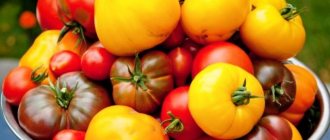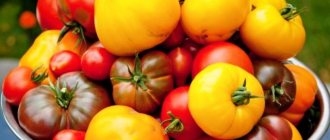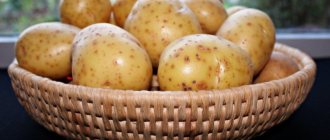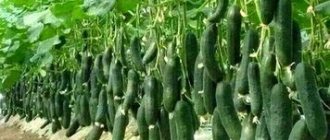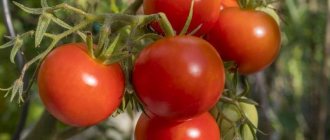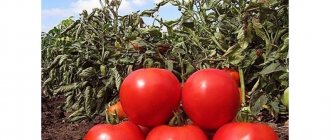Tomato craze
It all started with a dozen and a half amateur varieties purchased many years ago from a connoisseur of this crop.
In tomatoes, I discovered a new facet of plant life, because tomatoes are a cascade of colors, shapes and flavors. Having become “sick” with tomatoes, she constantly expanded her collection. I tried 400 varieties on my plot from many breeders and variety lovers. The variety of varieties is amazing.
Imagine: the sizes of the fruits range from the smallest – the size of a grape – to the huge ones – weighing from 200 g to 1 kg or more, and the colors from white, yellow and green to brown and dark purple, even blue-lilac, like the Lilac Lake variety, at first red, then with a tint. There are striped ones. The shape of the fruit is equally varied - some resemble grapes, cherries or plums, others resemble bananas or peppers, and others resemble lemons. There are almost rectangular fruits - Kornievsky rectangular.
My tomato plantation is divided into two parts - the main one and the experimental one. Every year I plant several dozen new varieties at the experimental plant. But it will be a great success if one or two of them migrate to the main site where I grow for you, my dear gardeners, interesting specimens identified during the selection. She is the pride and basis of the collection. The varieties of domestic breeders have firmly and long ago taken their place here.
My favorite varieties: Potato raspberry (break it, and everything sparkles, as if someone poured sugar), Astrakhan, Scarlet Sail, Abakan pink, Alsou, Babushkin Secret, Barmaley (the earliest of the greenhouse varieties), Bashkir handsome (fruits up to 800 d), Honey Spas, Malachite Box (with melon flavor), Tanka's truffles, Southerners (can't hold a brush in your hands).
I can’t list them all, one is better than the other. Varieties sent from abroad only a year or two have replaced some in my collection - Ferris Wheel, Tlacolula, Georgian.
This year I decided to plant more foreign varieties. I thought about these names like Virginia Sweets, Yellow-Pink Strawberry, Heart of Boeda. And the cost is not my 20 rubles, but as much as 80 rubles for 5 pieces, 50 rubles, rarely 30 rubles. I thought that this was probably fantasy and not fruit, but what I got was not what I hoped for. There is no sweetness, and “strawberries” are yellow fruits. True, Brad's hearts are black, but very few. And from almost a hundred varieties I took the Australian, the French variety Coeurs Boeuf. The Bulgarian variety Palka - for its original decorativeness; it’s simply hard to believe that the leaves are shaped like a rose. Having tested hundreds of varieties, I still found the most delicious, as they say, under my feet - Bochonok, Berdsky large, Russian soul, Pink honey, Pudovik, Syzran, Fartovy, Soviet, Olympic flame, Batyanya. Tall varieties decorate the site, the plants are beautiful, the fruits are tasty and productive. But at the same time, one cannot do without low-growing varieties, which are less demanding and more convenient than tall ones. They produce a harvest quite comparable to the harvest of tall trees at much lower labor costs. This circumstance should be taken into account by beginning tomato growers. Start with the simple, but also the most important, with the selection of varieties and mastering agricultural techniques. I left the very early and early varieties from the low-growing ones. At first, among the low-growing varieties, I was dominated by good varieties, and even now they are at their best - Altaechka, Baron, Vzryv, Gina, Danko, Kind Fairy Tale, Chinese Early, Kubyshka Sibirskaya (it can also be stored for a long time), Natalie, My Family, Visibly and Invisibly , Snow Leopard, Klusha, Mongolian dwarf, Craiova, Cornet, Little Red Riding Hood and dozens of other wonderful varieties. This year I offer lovers a very original Marmeladny variety. When you look at him from afar, it seems that he is dressed in green lace. The fruits under the leaves are tasty, dense, and the most important advantage is that the variety is never affected by late blight.
The amateur variety My Luck is 60-70 cm high, strewn with oblong large red fruits. Some of them are the size of a palm, tasty and have a long shelf life; they just sit in a box in the room for 3 months. Interesting varieties are Sakhalin, Kibits, Bird of Happiness, Summer Resident, Besrassadny, Ladies' Man, Burkovsky Early, Demidov, Lazy Man's Miracle. Of course, I couldn’t name all of the best varieties in my article. Anyone who is interested in my collection can get acquainted on the Ogorodnikoff website page or by typing “140 varieties of tomatoes from Ishimtseva” into the search engine.
Lidiya Ishimtseva
I will send a free catalog to everyone who wants it in an envelope signed by you.
To receive seeds, send a self-addressed envelope, a photocopy of the receipt and a list of the varieties you have chosen. Minimum order – 300 rubles + 70 rubles for sending by registered mail.
I send seeds by prepayment, you can pay at the post office - by postal order or through Sberbank to card No. 6390 0272 9013 5833 53 by sending an SMS to the phone number.
You can order seeds by email, this is convenient for you and for me.
Write: 456531, Chelyabinsk region, Sosnovsky district, village. Sargazy, st. Sirenevaya, 13, apt. 2, Ishimtseva Lidia Iosifovna.
Tel. home: 8 (351) 44-99-3-36; cell MTS: 8-919-115-7904; Tele2: 8-950-748-3741.
(Ural Gardener No. 7, February 2016)
Ultra-early and early foreign varieties
On seed packets, breeders indicate the growing season or ripening period, that is, the number of days the plant needs to enter the fruiting stage. The countdown begins from the moment the first shoots appear. Tomato seeds take an average of three to six days to germinate.
Tomatoes from the Japanese company Kitano
Ultra-early varieties make it possible to harvest the first tomatoes already 70-75 days after germination. Early - on the 90th day.
Japanese selection and its features
Japanese seed supplier Kitano Seeds manages to combine the benefits and beauty of vegetables with the ease of growing. The noteworthy variety “Kibo F1” belongs to indeterminate hybrids; it has powerful shoots, on each cluster of which five or six fruits of the same round shape are formed.
The average weight of a tomato is 320-340 g. There is no green spot at the base of the stalk. Even under stressful growing conditions, the hybrid sets fruit well and demonstrates resistance to cracking. "Kibo F1" is considered one of the best among pink-fruited tomato varieties for greenhouses: the tomatoes are tasty and store well.
Japanese harvest "Kibo F1"
Dutch and Swiss hybrids
Manufacturer Rijk Zwaan (Holland):
- "Abelus F1" (Abellus) is a good hybrid that demonstrates high resistance to cladosporiosis, nematodes and TMV (tobacco mosaic virus). Belongs to the Mediterranean type of tomato, the fruits are flat-round in shape, have a uniform color, dense flesh and shiny skin. The taste is excellent, the tomato aroma is noticeable. Average weight – 140-170 g.
- "Abelus F1" is considered a high-yielding tomato hybrid for greenhouses with early harvest. The growing season is 90 days. Plants are compact in shape with short internodes, growth type is indeterminate.
Tomato hybrid for greenhouses Abelus F1
The Syngenta company (Switzerland) supplies “Gravitet F1” - an early productive hybrid for any greenhouses. Demonstrates resistance to TMV and verticillium. The average weight of tomatoes is 200 g, their shape is smooth, round, dark red in color, and the skin is shiny. Plants are of the generative type, that is, they are more prone to fruiting than to developing green mass, therefore they have shortened internodes and practically do not form stepsons.
Each plant forms seven to nine clusters and has a powerful root system. "Gravitet F1" produces fruits that are resistant to green spots. The hybrid is considered unpretentious and produces crops on soils of any composition.
Unpretentious "Gravitet F1"
Basic principles of growing tomatoes in the Urals. Advice from an experienced gardener
My mother-in-law used to say: “Tomatoes are like nettles - no matter where you throw them, they will grow everywhere.” And indeed, I remember how they carried tomatoes on a cart - there were a lot of them. They didn’t do anything with them, the only thing I saw was my mother walking across the field. They planted a lot, and she pinched the tops of the tomatoes. This is how it was 20-30 years ago. But that time has sunk into oblivion.
No matter what the weather forecasters say, climate change is obvious. Nowadays winter is not winter, and summer is not summer. And the proverb “You can’t pull a fish out of a pond without effort” entirely applies to those of us who want to get high yields. 40 years ago I was in the Krasnodar region, in the Rostov region, in the Crimea, Yalta, and I got the impression that this is such a region - if you threw a seed into the bare ground, it will still germinate. There is a sea of tomatoes at the market. Communicating with southerners over the past four years, I say that this is a “risky farming zone” in the south, and not here in the Urals, in Siberia. It's hot, it rains for weeks, and in some areas it can be acidic. Late blight sometimes nullifies all the gardener’s efforts.
I visited Turkey for two years in a row. Already approaching Alanya, I noticed the greenhouses. There are greenhouses everywhere. Tangerines grow in greenhouses, as well as some other fruit trees. Each piece of land is occupied by long ridges under arcs, only the ends of the ridges are open. Eggplants, peppers, tomatoes, and strawberries grow there. It seems to me that everything is under film. But what I noticed is that inside the ridges there is also a protective covering material attached to the arches, and then a film. Everywhere in the fields and gardens there is drip irrigation.
From what I read, what I saw in practice, and from communicating with Russian gardeners, I formed my own basic principles.
The first and main thing is orientation towards protected ground.
In conditions of high humidity and sudden changes in day and night temperatures, this is necessary. In the Urals this year in the summer it was 30 degrees during the day and +8+9 at night. In the southern regions there are winds and rains. Protected soil is the only opportunity to get a return on the labor expended. My greenhouse is covered with film, the only heater is the sun. In this greenhouse I grow both tall and short-growing tomatoes.
The second principle is growing your own seedlings
Practice has shown that any gardener can grow 100 tomato seedlings on his windowsill, especially since now there is no shortage of lighting. If possible, I prepare soil for seedlings from equal parts of good humus and vermiculite. Where there is no vermiculite, the soil may consist of turf soil, humus and 1/3 sand. It is necessary to add mineral fertilizers. Particular attention should be paid to soil disinfection. I steam the soil. This guarantees the protection of seedlings from fungal diseases. But if the seedlings begin to fall out, then fill the ground with calcined sand and pour in a weak solution of copper sulfate. As a rule, this helps.
I start growing seedlings in early March. Sowing depends on how early you can provide a feeding area for the transplanted seedlings in cups and in the ground. The sooner you sow your seedlings, the sooner you should plant them in the ground. Seedlings are planted at 50-60 days old, so sow from this date. Your own home seedlings, even sown late, give the best harvest.
The third principle is to grow only those varieties that are suitable for your site
Precisely a site, because each site, and not just a district, region, region has its own microclimate.
I have tested hundreds of varieties. I tried to grow European varieties, varieties from different breeders. I received feedback from gardeners from different regions of Russia, Belarus, Germany and Ukraine.
Practice has shown that varieties of Novosibirsk, Siberian, Altai selections feel great both in Siberia and in the south of our country. Ukrainian experimental master Alla Mishneva wrote to me: “ Your Siberian seeds are going great with us! " Our varieties perform excellently in Belarus and Kazakhstan. Many times I sent our Russian varieties of tomatoes to Germany: “Potato Raspberry”, “Abakan Pink”, “Alsu”, “Pride of Siberia”, “Honey Spas”, “Monastic Meal”, “ Siberian Abundant ”, “Northern Beauty”, “ The Tsar's Favorite ", "Mom's Siberian", " Siberian Trump ", "Hospitable", "Heavyweight of Siberia".
The fourth principle is to use agricultural technology proven by personal experience.
In the fall, I dig up the soil and add humus. I plant the seedlings in a greenhouse, if I can cover the seedlings, the sooner the better, if not, then I wait for the warmth. I make a hole as deep as a shovel bayonet and wide, add a glass of ash and a spoonful of superphosphate.
Recently I started adding a spoonful of calcium nitrate for blossom end rot. I mix all this with the soil taken out of the hole and water it. I bury the seedlings down to the cotyledon leaves. After planting the seedlings in the ground, I do not water them for 10 days.
Bashkir handsome tomato
Bashkiria does not have a warm climate. The period of positive temperatures lasts on average 135 days. At the same time, the snow cover disappears in mid-April and falls in early November.
The moderate temperatures of Bashkiria make it possible to grow different varieties of tomatoes in open ground.
However, to obtain the best result, it is important to decide which varieties of this crop will best take root in the territory of Bashkiria.
If we talk about growing tomatoes in open ground, then these should be early and mid-early varieties that ripen in a short time and allow you to get a harvest quickly. As a rule, plants in open ground require special care: their condition is affected by factors such as precipitation and wind.
To make the plant feel good, it is better to choose low-growing tomatoes for open ground. Standard varieties do not require special attention. It is also worth noting that the variety should be selected depending on the intended purpose: salads or canning.
The easiest way is to choose universal varieties that are ideal for both consumption from the bush and for harvesting for the winter.
The best varieties of tomatoes for Bashkiria
"Agatha". This is an early-ripening tomato, whose maturity occurs on the hundredth day after planting the seedlings in the ground. Its bushes are low-growing, not standard, and grow up to 45 cm.
The yield is decent - at best, about four kilograms per plant. “Agatha” is rightfully included in the best varieties of tomatoes for Bashkiria.
This variety is universal: the tomato is suitable for fresh consumption and for storing for the winter.
Tomatoes are intended for growing as seedlings, however, you can plant the seeds directly in open ground. Its red fruits weigh on average 85 grams. The maximum weight reaches one hundred grams.
A maximum of six tomatoes are formed on one bunch, which are distinguished by their sweet, dessert taste. It cannot be said that “Agatha” has good immunity to disease. It can be affected by late blight, but usually it ripens before this disease affects the crop.
The variety definitely needs pinching, as tomato bushes grow very strongly
"White filling".
Dacha forum: dacha, garden, vegetable garden, flowers
Another variety that can be grown well in the open ground of Bashkiria is called “White filling”. This is an early, cold-resistant tomato, the bushes of which are not standard. The low-growing variety grows no more than 50 cm. There is no need to tie it up. Red tomatoes are not prone to cracking and weigh approximately 130 grams each. One plant usually produces three kilograms of yield.
“Siberian early ripening.” In open ground conditions, the height of the bush reaches 45 cm, although in a greenhouse the plant grows up to 96 cm. Red tomatoes weigh about 110 grams. The variety produces a harvest at the same time. The taste is good, although, according to reviews from gardeners, it is not particularly remarkable. It is used both fresh and canned.
Under growing conditions in unprotected soil in Bashkiria, the yield can reach seven kilograms per square meter. In terms of weight, this is approximately 600 grams per bush.
Worth it, grown in an unprotected area, will be superior in taste to plants of an identical variety grown in a greenhouse.
"Gruntovy Gribovsky". The best varieties for Bashkiria are also represented by this variety. This is an early ripening tomato that is resistant to cold. Maturity occurs at 96 days.
The bushes are standard, grow up to 50 cm and do not require procedures such as gartering or pinching. Red tomatoes weigh about 150 grams each. "Ground Gribovsky" is often grown without seedlings.
Its fruits are consumed fresh or used for preservation.
"De Barao." This is a very interesting tomato, which is also among the best varieties for Bashkiria. Its fruits can be black, yellow, pink and red. But regardless of the shade, plants of this variety have a lot in common. Its bushes are indeterminate, which means its height is large. Ten fruits are formed on each cluster.
This indicates high productivity. On average, gardeners harvest about four kilograms from a bush. The variety belongs to the mid-late variety, but it can be grown in the open ground conditions of Bashkiria. Usually "De Barao" is consumed in salads. Its positive quality is the ability to successfully ripen after removal from the plant, as well as a long shelf life.
"Novikov's Giant" This is a mid-season variety with a ripening period of 125 days. But in the climatic conditions of Bashkiria, it still has time to produce a harvest before frost. The color of its fruits is pink. Each tomato weighs a maximum of 700 grams, but in special cases the fruits can weigh about 1.5 kilograms. Therefore, gardeners can easily harvest up to ten kilograms of tomato harvest from one bush.
"Bull's Heart" This is one of the most favorite varieties among gardeners. It is large in size and has excellent taste. The fruits are fleshy, but there is less juice than other varieties. Their taste is quite sweet. “Bull’s heart” is usually consumed fresh, since the variety is not suitable for preservation.
This is a determinate plant, the height of which can reach up to 160 cm. If the plant is cultivated in the open ground conditions of Bashkiria, the yield from one bush reaches five kilograms. And in a greenhouse it often reaches 12 kilograms per plant. Its ripening period is 124 days.
The plant produces tomatoes of varying weights.
"Peremoga -65". An early ripening plant ripens on the 114th day. This is a standard variety that grows up to 50 cm. However, it requires pinching, but moderate. Five fruits weighing up to 120 grams are formed on the bush. The variety is resistant to temperature changes and is sufficiently unpretentious that it can be easily and simply grown in the soil of Bashkiria.
“New in Transnistria.” The variety is classified as semi-determinate. In terms of timing, it is medium early. The bush reaches a height of 1.2 meters, but even with this growth it is usually cultivated in open ground.
Naturally, he will need a competent garter. The variety is high-yielding, although the weight of the fruit rarely exceeds 90 grams.
But a lot of fruits are formed consistently, especially if you leave four stems each.
"Stolypin". If we turn to the most modern selection, we can try to plant the “Stolypin” variety. This is an early ripening variety, ripening on the 86th day.
Its bushes are not standard, determinate, grow up to 60 cm. When cultivated in greenhouses, the yield per square meter reaches about eight kilograms.
In open ground it will be a little lower, but still at a decent level. The weight of the fruit reaches 120 grams.
"Stolypin" is immune to late blight. It has excellent taste. The variety tolerates cold well and does not crack.
"Cupid". The hybrid belongs to the determinant ones. Its fruits ripen on the 90th day after the seedlings are moved into the ground. The hybrid bushes stretch up to 60 cm and bear fruits weighing one hundred grams. It has good drought resistance and immunity to disease.
"Legionary". This type of tomato can also be grown outside of Bashkiria. It ripens very early - in 90 days. The height of the plant reaches only 60 cm, but its branches are spreading. The fruits have a pink tint and a pleasant taste, so they are most often used for salads. Legionnaire is extremely resistant to tomato diseases.
"Gina." One of the best varieties for Bashkiria is “Gina”. This plant bears large fruits, although its bush grows only up to 60 cm. “Gina” requires the removal of excess stems and a garter.
The weight of a tomato reaches about 250 grams, but gardeners often remove tomatoes weighing 350 grams from a bush.
Therefore, the variety’s yield is high – about 10 kg per square meter. The shade is orange. Their taste is extremely sweet and juicy.
Tomatoes ripen on the 110th day. The variety is immune to verticillium and fusarium.
Whichever of the above varieties you choose for growing in the open ground of Bashkiria, be sure of the stability and quality of the harvest. All fruits will delight you with their smooth ripening and sweet, juicy taste, and caring for most of the plants will not require much effort.
Catalog of tomatoes by Ishimtseva Lidia Iosifovna
Source: https://baseperevozok.ru/tomat-bashkirskij-krasavec/
Lydia – variety of tomato plant
Variety characteristics:
Properties of the Lydia variety:
Recommended region on the map:
Information about the admission of Tomato Lidiya from the Register of the State Variety Commission of the Russian Federation
Application for admission No. 32227, registered 1999-01-27. The Tomato variety Lidia was included in the register of approved varieties in 2000. Approved for use in regions: All regions.
The originators of the Tomato Lydia variety are:
Other varieties of tomato plant
Search for variety by name
Variety selection
Description of the Chelyabinsk meteorite tomato, agricultural cultivation technology and care
The Chelyabinsk meteorite tomato is included in the State Register of Breeding Achievements. The variety appeared recently, but quickly gained popularity among vegetable growers due to its resistance to the vagaries of nature and universal use.
Advantages of a hybrid
The Chelyabinsk meteorite F1 tomato variety is intended for cultivation in regions with harsh climatic conditions. The hybrid is zoned for planting in the middle zone, Siberia, and the Urals.
An early ripe tomato begins to bear fruit 95-105 days after germination. During the growing season, depending on the growing conditions, a bush 120-150 cm high is formed, requiring shoots to be removed and tied to a support.
Plant with medium amount of foliage. To increase the productivity of the crop, the bushes are grown in 2-3 stems, leaving 2 leaves above the brush. The flowering raceme is simple, 5-8 fruits weighing 55-90 g ripen in it. The yield of the hybrid is 16 kg per 1 m².
The tomato variety Chelyabinsk meteorite, the characteristics and description of the variety indicating resistance to adverse weather conditions, is distinguished by stable fruiting. The hybrid retains the ability to form ovaries in dry conditions and cool weather.
Ripe fruits can be stored for a long time and can easily be transported over long distances. Reviews from vegetable growers indicate that Chelyabinsk meteorite tomatoes are unpretentious in care.
In cooking, tomatoes are used fresh for preparing various dishes. Tomatoes are ideal for canning and retain their shape during heat treatment.
Agricultural technology for tomato cultivation
The hybrid is grown using seedlings. The prepared substrate, consisting of fertile soil and humus, is poured into the containers. It is lightly compacted and grooves 1 cm deep are made.
To ensure the friendly emergence of sprouts, the seeds are pre-treated with an aqueous solution of aloe juice and a growth stimulator. To improve germination, tomato seeds are placed in warm water for 48 hours.
If there is a nutritious colored shell, the planting material does not need to be processed. Seeds of this type are coated with a nutrient mixture containing all the substances necessary for sprouts.
For normal development, seedlings require the following conditions:
- temperature regime;
- constant ventilation;
- additional lighting, timely watering;
- periodic fertilizing with complex preparations.
In the phase of formation of 1-2 true leaves, picking is carried out. This event allows you to cull weak plants and ensure the normal development of seedlings intended for planting in the ground. When growing seedlings in separate containers, do not pick.
It is convenient to cultivate tomatoes using peat tablets, into which 2-3 pieces are placed. seeds After germination, a strong plant is left behind. This growing method allows you to preserve the root system from damage.
Tomatoes are transferred to a permanent place 55-60 days after germination. Such seedlings reach a height of 30 cm and have 6-7 formed leaves and 1 flower cluster.
Planting care
The planting site is pre-selected taking into account crop rotation. The best predecessors for tomatoes are legumes, cabbage, cucumbers, and carrots. Before planting, the soil is treated with a disinfecting aqueous solution of potassium permanganate.
The bushes are planted at a distance of 40 cm from each other, leaving a gap of 50 cm between the rows. The plants are moved without breaking the earthen ball, covered with soil, and watered abundantly with warm water.
You can regulate the balance of moisture and air, provide drip irrigation and prevent the growth of weeds by mulching the soil. For this purpose, straw, leaves or non-woven black fiber are used.
High returns from the bush can be obtained with constant care of the crop. Tomatoes require fertilizing with mineral fertilizers at different stages of plant formation.
High humidity promotes the development of fungal diseases. For preventive purposes, the bushes are treated with special copper-based preparations and the greenhouse is regularly ventilated. To combat biological pests, insecticides and folk remedies are used.
Landing in the ground
The timing of planting tomatoes in beds depends on soil and air temperatures: from the end of April in the south of Russia to the beginning of June in the northern regions.
There are different methods of planting tomatoes, among them you will even find unusual planting methods.
Chinese method
This tomato planting scheme is suitable for tall varieties grown in a greenhouse:
- Seeds are planted a month earlier than usual.
- After 4 weeks, sprouts with 4-5 full leaves and a height of 10-15 cm are cut off almost to the root.
- Trimmed seedlings are placed briefly in Epin's solution.
- Then they are planted in new containers, burying the cotyledons into the ground, covering the top with plastic cups to create a greenhouse effect, and placing them in a dark place for 2-3 days.
- The seedlings take root and are transferred to their usual place.
- When planting in beds, holes are made at a distance of 60-70 cm, at the bottom of which a little ash is placed.
- Water for the first time after planting 5-7 days. If the weather is hot and sunny, the planted bushes are shaded with spunbond to prevent sunburn.
The Chinese method of planting tomatoes is considered one of the most popular.
Lyudmila Terekhina's method
This method is a modification of the Chinese one (Lyudmila also advises cutting seedlings and sowing them with rooting in new cups), but with some additions. Let's see how the tomato planting technology from Lyudmila Terekhina works:
- sow on the waning moon;
- how to soak tomato seeds before planting: use melt water for sowing (soaked seeds planted in containers, cover with snow, after melting, place in a warm place for 5 days) and watering;
- At night, remove the seedlings to a cooler and darker place so that they do not stretch;
- dive on the waxing moon.
Galina Kizima method
If there is not enough space for seedlings, Galina Aleksandrovna Kizima’s method is very good - growing tomatoes in “diapers”.
- Place 2 tablespoons of soil on plastic bags and place a sprouted seed.
- The polyethylene is folded from the bottom and wrapped, the resulting “diapers” are secured with an elastic band. The film helps retain moisture and creates a greenhouse effect.
- When the seedlings grow up, add another spoonful of soil. Water as they dry out and feed with mineral fertilizers once a week. The roots are not cut.
When to plant tomatoes? When the seedlings grow:
- Holes 20-30 cm deep are filled with down, feathers from an old pillow (they rot well and give the plants silicon, which strengthens their blood vessels) and a tablespoon of superphosphate.
- Pour 5 liters of water into the planting hole. Seedlings planted in “diapers” have long roots that grow straight down, without branching or spreading close to the soil surface. This allows you to avoid watering the tomatoes throughout the growing season.
- Plantings are mulched with old newspapers or paper - it does not allow moisture to evaporate and protects against weeds.
Planting tomatoes according to the lunar calendar
Planted taking into account the influence of the phases of the moon (look at the lunar calendar), tomatoes will grow a strong root system and develop correctly.
The lunar cycle consists of several phases: new moon, 1st quarter, full moon, last quarter, new moon again. In the 1st week after the new moon, the root system develops intensively. From the 1st quarter to the full moon, leaves appear, and seeds germinate well. From the full moon to the last quarter, leaf growth slows down, but roots grow actively - this is a good time to replant plants. From the full moon to the last quarter, the plant rests, and all vegetative processes slow down.
Based on knowledge of the lunar phases, it is recommended:
- 2 days before the new moon, plant tomato seeds;
- from the full moon to the 3rd week of the lunar month, pick up seedlings or transplant seedlings into beds.
Maslov method
An engineer by training, I.M. Maslov, offers a simple technique that increases yields by 80%.
Tomatoes easily grow lateral roots from whitish tubercles on the stem. If such a section of the stem falls on the ground, the root will begin to grow, while the plant itself will lie on the ground and will develop further without any garter.
The author of the method suggests growing tomatoes in two original ways:
- A trench 10-13 cm deep is dug in the garden bed, oriented from north to south. The seedlings are placed in a trench with the top to the north so that the root and two-thirds of the stem (the leaves must be torn off) lie on the bottom. As they grow, the sprouts straighten to the south.
- The lower lateral shoots on the stems, which are usually cut off, are left in place and allowed to grow. Then some of the leaves are removed and stapled next to the main plant, covered with a mound of earth (10 cm) and allowed to take root. The grown stepsons will produce a lot of fruits that will set close to the ground.
Brief information about the variety
- Fruits and bush: tomatoes weighing 50-90 g, round in shape, have a pleasant taste. The bushes are medium-sized (120-150 cm high), medium-leaved.
- Productivity: high, 3-4 kg of fruit can be harvested from one bush under favorable conditions;
- Resistance: the variety is resistant to diseases typical of tomatoes, most often affected by root rot and late blight. Requires preventive treatments.
- Distribution: capable of bearing fruit abundantly in all regions of the country. In the north, exclusively greenhouse growing methods are used.
- Application: the fruits are universal, suitable for fresh use and home canning.
- Planting: predominantly seedling method of cultivation, seed sowing time - March - April, seedling planting time - May - June, scheme: 3-4 bushes per 1 m².
- Care: the variety requires the formation of a bush of 2-3 stems, regular pinching and tying to a support. Needs fertilizing with organic and mineral fertilizers throughout the growing season. Watering is carried out as needed with warm, settled water.
- Ripening period: average, fruiting begins 4-4.5 months after sowing the seeds and occurs in July. The shelf life of the fruit is average.
